First Panda Lady Has Died
Posted by: Loren Coleman on May 19th, 2008

Joined by her husband, Jack (left), and brother-in-law Quentin Young is Adelaide “Su-Lin” Young. Photo courtesy of her family.
Forget about the fictional “Indiana Jones,” or even the real “Zoology Jones,” for a minute. Recall, please, that women were part of the early exploration adventures too!
Ruth Harkness is often remembered as the first woman to have found the giant panda. But why was that first cub named Su-Lin? Here is the rest of the story.
After Ruth Harkness’ husband William died as he set out to find the first live giant pandas, she turned to a man only identified at the time as “Zoology Jones” for advice.
In a race to find the first live panda, Harkness soon found herself pitted against “Zoology Jones” (probably Tangier Smith). But Harkness won the race, and on November 9, 1936, as she wrote in her diary, her guide Quentin Young caught sight of a baby giant panda inside an old dead tree, thought to be the den of the cub’s mother. Young handed it over to Harkness. The panda was named Su-Lin, after Quentin’s brother, Jack Young’s wife, since it was believed to be female (this later turned out to be incorrect). The name means “a little bit of something very cute.”
The once-overlooked but now celebrated and very real “Panda Lady” – Adelaide “Su-Lin” Young – sadly has died at the age of 96.
Images and tributes related to Su-Lin’s life and her namesake giant panda, a significant “animal of discovery,” are shared here, as they reveal much about those first days of the first giant pandas.
Adelaide “Su-Lin” Young was the subject of books and international press coverage as the first American woman explorer to enter the Tibetan-Himalayan area and part of the expeditions that brought back the first giant panda to the United States. (Photo courtesy Jolly Young)
Epitaph
Adelaide “Su-Lin” Young
Born: Dec. 23, 1911, in New York City, New York.
Died: April 17, 2008, in Hercules, California.
Survived: Daughters Jackie Wan of Hercules, Jocelyn Fenton of Dallas and Jolly King of Honolulu; one granddaughter and one great-grandchild.
Services: A celebration of life will be held later this year when Young will be laid to rest alongside her parents in New York.
It was a honeymoon for the history books, one that, 74 years later, brims with the kind of details that novelists and screenwriters can only dream about.
Adelaide “Su-Lin” Young, a longtime El Cerrito resident who died April 17 in Hercules [California] at age 96, was known as “the Panda Lady” and is credited as the first American female explorer to trek into the rugged Tibetan-Himalayan area.Her true-life adventures in the 1930s, since recounted in books and discussed as movies, seemed improbable for a young Chinese-American woman raised in an upper-middle-class home in New York. And it all started with the 1934 “honeymoon” the young bride embarked on with her new husband, Jack Young.
“My father was an explorer and naturalist who was going to the university in New York when my mother met him,” said daughter Jackie Wan of Hercules. “They fell in love and she married him.”
The honeymoon was actually a 10-month, three-person expedition on a slow boat to China, where the newlyweds and Jack’s brother, Quentin, were to collect bird and animal specimens and catalog plants for the American Museum of Natural History. The journey was financed by Theodore Roosevelt Jr. and Kermit Roosevelt, two of President Theodore Roosevelt’s three sons.
Su-Lin Young was a native of New York City, where her father, Ming Tai Chen, owned the famed China Doll Night Club, which hosted the big bands of Paul Whiteman, Benny Goodman and other famous acts of the day.
The diminutive Young would say in later years that her only preparation for her expeditions to China and the Himalayas came from her time as a counselor at Camp Interlaken in New Hampshire.
Photos from the trip show a smiling Su-Lin Young with a pistol on her side.
“Mounted trophies were the custom at the time of her travels, but early on, after shooting a large Asian bear, she vowed never to kill another animal,” recounted daughter Jolly Young of Honolulu. “Because of this incident, she became instrumental in influencing the Young family to ‘bring ’em back alive.'”
On that first and subsequent expeditions, Chinese-Americans Jack, Su-Lin and Quentin Young covered territory in China, Tibet and parts of India little explored by adventurers from the West.
“Parts of her travels were made with only a single guide/interpreter and her accounts detail sleeping in and around monasteries, lamaseries, palaces, tents and yurts with her loaded pistol under a makeshift pillow,” Jolly Young wrote in a summary of her mother’s life. “As the sole woman in the company of men, she was an oddity if not scandalous. In many areas she was the first ‘foreign’ woman local inhabitants had ever seen.”
As rough as the expeditions themselves were, Su-Lin had other hardships. Two of her three daughters were born on expeditions to the Far East.
“She told us about being evacuated twice from China while traveling with a toddler and a baby,” said Kathy Haaga, who interviewed Young for an exhibit at the Memphis Zoo in Tennessee.
In all, Young went through three evacuations from China and survived Japanese bombing raids in the years prior to World War II.
“I asked her if she would do it all again knowing what she knew, and she said, ‘No way,'” Haaga said.
“She was a very tough woman,” Jackie Wan said. “She was a trooper, very smart, very sociable. She really had an exciting life.”
The expeditions resulted in the arrival of the first live panda, named Su-Lin in her honor, to the United States. The Explorers Walk, an exhibit at the Memphis Zoo, credits her as one of three explorers who opened the East to the West, along with Marco Polo and naturalist Father Armand David [who is often remembered for Père David’s deer, Elaphurus davidianus – LC].
Young’s experiences didn’t end there. An alumna of Wesleyan College in Macon, Ga., she was once a disc jockey for the MAAG American station in Formosa (now Taiwan), and in the 1930s contributed several articles to Arthur Sowerby’s monthly China Journal and wrote society articles for a Shanghai newspaper. In later years, she worked for the Social Security Administration in the San Francisco Chinatown branch and lectured and wrote about her travels.
Donations: Donations in her name can be made to the Sutter VNA & Hospice Foundation, 1900 Powell St., Ste 900, Emeryville, CA 94608 or the World Wildlife Fund, P.O. Box 97180, Washington, D.C., 20090.
Source: “Life of ‘Panda Lady’ celebrated,” by Chris Treadway, West County Times, 05/16/2008.
The Brookfield Zoo’s original Su-Lin of 1936.
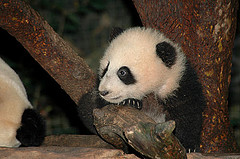
The San Diego Zoo’s present-day Su-Lin of the 21st Century.
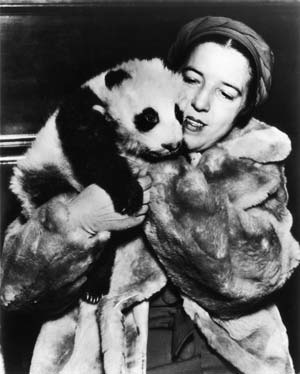
Ruth Harkness brings the first Su-Lin to the United States. Photo courtesy of Mary Lobisco.
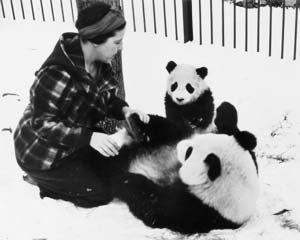
Ruth Harkness helps introduce Su-Lin to the second live-captured giant panda, Mei-Meil at Chicago’s Brookfield Zoo. Photo courtesy of Mary Lobisco.
In the 1930s, Adelaide “Su-Lin” Young, the pampered and glamorous daughter of a New York nightclub owner, morphed into one of the first female explorers to venture into the part of China devastated by last week’s earthquake.
It was an unlikely transformation that led to an unusual distinction: She became the namesake for two giant pandas living in the United States.
“She was very strong,” Jackie Wan said of her mother. “She had to be to do what she did.”Mrs. Young died on April 17 of natural causes in a home-care facility in Hercules. She was 96.
Born in New York City in 1911 and raised by a family that had its own chauffeur, she traded luxury for adventure when she married explorer Jack Young in 1933.
The next year, the bride left with her husband, brother-in-law Quentin Young and others on a nine-month expedition to China to acquire specimens for the Museum of Natural History in New York.
“As the sole woman in the company of men, she was an oddity if not scandalous,” said Jolly King, one of Mrs. Young’s three daughters. “It was not accepted at that time.”
Mrs. Young, believed to be the first American female explorer to enter the Tibetan-Himalayan region, figured she could apply the skills she’d acquired at camp in the White Mountains of New Hampshire. It was harder than she thought.
In China, she learned to cook over a campfire in the snow, make bread in a discarded tin, sleep with a loaded pistol under her pillow to fend off bandits, and take shelter where she could, including Tibetan yurts, when the rest of the expedition was elsewhere. She drew a crowd wherever she went, even while doing something as simple as brushing her teeth.
“People would watch her bathe,” said Boston writer Vicki Croke. “She was viewed by the Chinese as an American and by Americans as Chinese – she was really between cultures, and it was liberating for her.”
On Mrs. Young’s 90th birthday, Croke interviewed her for “The Lady and the Panda,” a book she wrote about another female explorer, Ruth Harkness, that came out in 2005.
“She was vivacious and self-deprecating,” Croke recalled. “And Harkness was charmed by Su-Lin.”
She must have been: In 1936, when Harkness brought the first live giant panda to the United States, she named it Su-Lin, which means “a little bit of something precious.” The description, Croke said, applied to both the human and the bear.
Mrs. Young was working as a reporter for several publications in Shanghai, including the China Journal and North China Daily News, when she met Harkness.
“She had some admonishing advice for Harkness,” Croke wrote. “The travel would be dirty and uncomfortable. In Tibet, Su-Lin had sometimes stayed in yak-hair tents, drinking yak-butter tea, warmed over a yak-dung fire. Everything she ate was suffused with stray strands of yak hair. The smell of it all was unfortunately unforgettable to her.”
Equally memorable, King said, was an incident that traumatized her mother for many years: Handy with a rifle, she shot to death a large Asian bear on her first expedition to China.
Although mounted trophies were customary in those days, Mrs. Young vowed never to kill an animal again and persuaded her husband and brother-in-law to bring creatures back alive instead of dead.
King said the Young family explorers brought a half-dozen pandas to the United States. The one that Harkness named for Su-Lin Young lived in the Brookfield Zoo in Chicago and is mounted in that city’s Field Museum. The second Su-Lin resides at the San Diego Zoo.
“My mother would say, ‘That’s nothing,’ but the first thing she’d do was show people pictures of them,” King said. “Bottom line: She was thrilled.”
Kathy Haaga met Mrs. Young in 2001. Haaga, the Memphis Zoo’s former exhibits coordinator, was creating a tribute to three explorers who opened the East to the West: Marco Polo, Pere Armand David and Mrs. Young.
“I met her through my brother, who was her physician in North Carolina,” Haaga said. “He’d mentioned that I was working on the panda exhibit. She said, ‘Oh, I know a little something about pandas.’ She was so humble and so matter of fact about these amazing things she had done.”
Mrs. Young was also a disc jockey in Taiwan and an employee at the Social Security Administration in San Francisco’s Chinatown from 1968 to 1977. She spoke a couple of dialects and helped people claim what was due them.
Until she was 90, she was able to drive and play golf.
Mrs. Young is survived by daughters King of Honolulu, Wan of Hercules and Jocelyn Fenton of Dallas, two grandchildren and one great-grandchild. Her husband, from whom she was divorced after more than three decades of marriage, died in 2000.
A memorial for Mrs. Young will be held in New York in September.
Source: “China explorer Adelaide ‘Su-Lin’ Young dies,” by Patricia Yollin, San Francisco Chronicle, Sunday, May 18, 2008
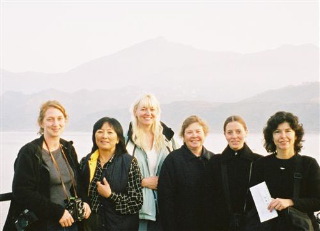
On the Yangtze, following the trail of the story of the giant panda: Meredith Heuer (Gourmet magazine photographer ), Jolly Young (daughter of Su-Lin and Jack Young, niece of Quentin Young), Robin Perkins Ugurlu (Hazel “Perkie” Perkins’ granddaughter), Mary Lobisco (Ruth Harkness’s niece), Nicole Lobisco (Mary Lobisco’s daughter), Vicki Croke (author of The Lady and The Panda).
Cryptomundo’s Best Historical Book on Cryptozoology for 2005
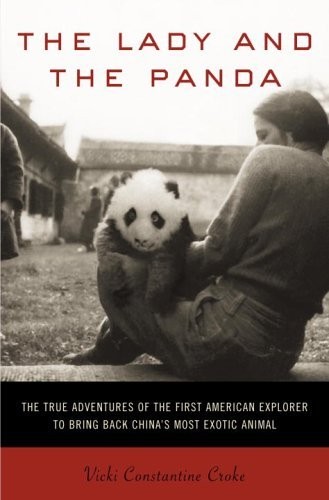
The Lady and the Panda: The True Adventures of the First American Explorer to Bring Back China’s Most Exotic Animal by Vicki Croke
About Loren Coleman
Loren Coleman is one of the world’s leading cryptozoologists, some say “the” leading living cryptozoologist. Certainly, he is acknowledged as the current living American researcher and writer who has most popularized cryptozoology in the late 20th and early 21st centuries.
Starting his fieldwork and investigations in 1960, after traveling and trekking extensively in pursuit of cryptozoological mysteries, Coleman began writing to share his experiences in 1969. An honorary member of Ivan T. Sanderson’s Society for the Investigation of the Unexplained in the 1970s, Coleman has been bestowed with similar honorary memberships of the North Idaho College Cryptozoology Club in 1983, and in subsequent years, that of the British Columbia Scientific Cryptozoology Club, CryptoSafari International, and other international organizations. He was also a Life Member and Benefactor of the International Society of Cryptozoology (now-defunct).
Loren Coleman’s daily blog, as a member of the Cryptomundo Team, served as an ongoing avenue of communication for the ever-growing body of cryptozoo news from 2005 through 2013. He returned as an infrequent contributor beginning Halloween week of 2015.
Coleman is the founder in 2003, and current director of the International Cryptozoology Museum in Portland, Maine.










Rest in peace Adelaide “Su-Lin” Young.
Condolences to her family, although 97 is a remarkable age.
There must be something about the Himalayan air, because another female explorer, Alexxandra David-Neel, who explored Sikkim and (illegally) Tibet in the early part of the 1900s lived to be just about 100 years old.